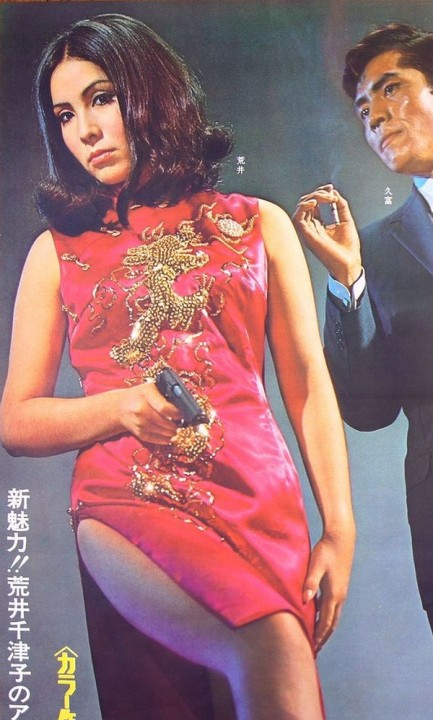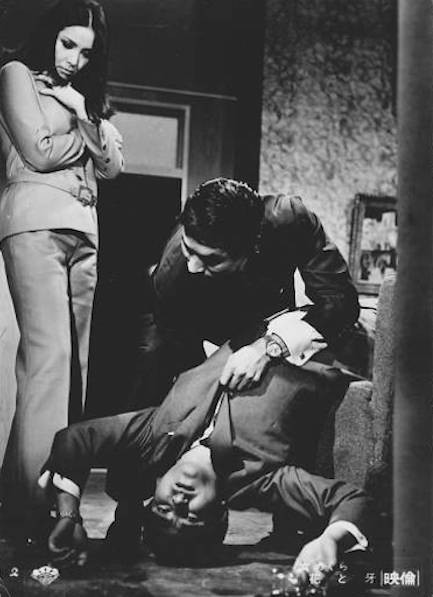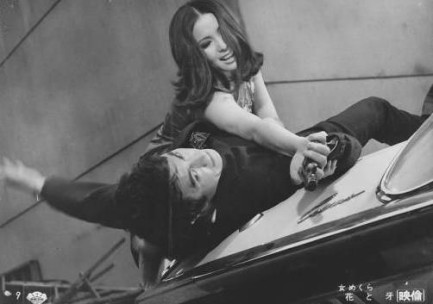 Bardot turns Paris upside down—again. 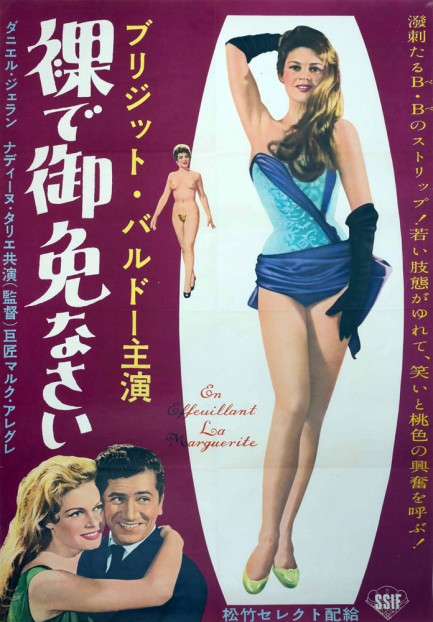 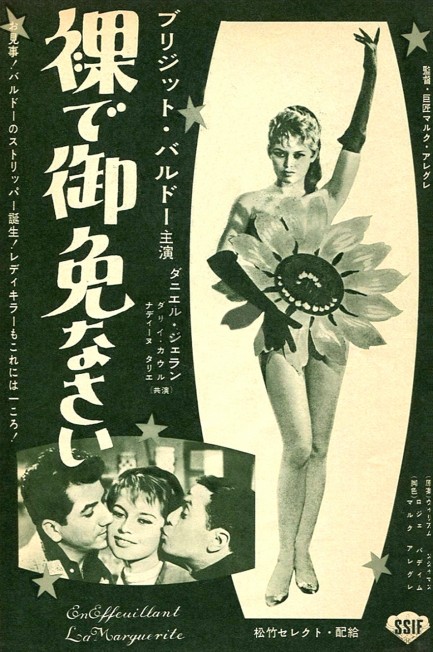
Above: a couple of alternate Japanese promos for En effeuillant la marguerite, aka Plucking the Daisy, aka Mademoiselle Striptease. We call them alternates, but actually, the one we shared last year was rare. The purple one here was the standard promo. The monochrome one, though, is also rare. You can read what we wrote about the film here. Shorter version: Bardot creates romantic chaos in Paris.
 Qipao! Qipao! The cheongsam killer strikes. 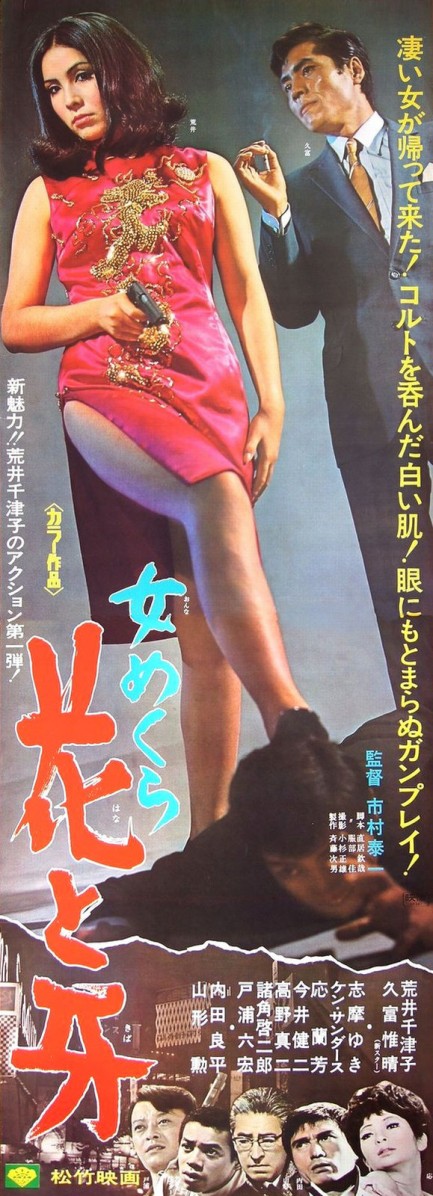
Two companies, same release date, but we've confirmed it with our Japanese sources, so don't blame us if it's wrong. Onna mekura hana to kiba, aka Blind Woman: Flower and Fangs also premiered today in 1968, starring Koreharu Hisatomi, Isao Yamagata, Ken Sanders, and Chizuko Arai, who you see fronting the poster in a killer silk cheongsam. For the boys out there, that's a traditional dress of Chinese origin also known as a qipao. Hope that enriched your day.
Arai plays a woman who returns to Japan from Hong Kong to find the truth behind the death of the father-figure Yaukza gangster who took her in as an orphan, raised her, taught her to shoot, gamble, and generally be a badass, but went over a cliff when his plan to attack a U.S. military transport along with four henchmen went wrong. Arai finds unexpected assistance in her search for answers, and learns that there was an unknown sixth person on the raid who may have stolen the money and betrayed the others. As you'd expect, the answers get even more complicated from that point, and danger mounts as someone resolves to stop her investigation in its tracks. In general the movie follows the basic blueprint of numerous other Yakuza crime thrillers, complete to the romantic subplot. We aren't sure if you'd call this entry a classic of the genre, but it's one of the better films of Arai's brief career. It's probably hard to find in the U.S., but if you can locate it we think it's certainly worth a watch, as are her other efforts. Onna mekura hana to kiba premiered in Japan today in 1968.
 It's just another case of Bardot being Bardot. 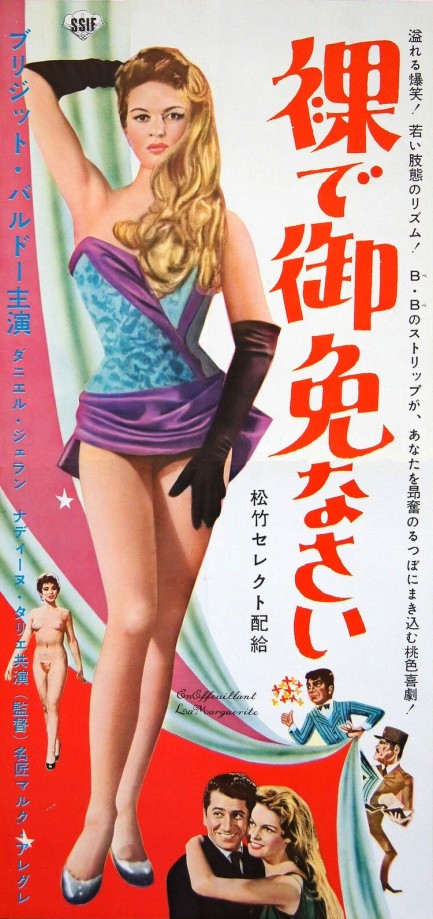
We don't know why, but Japanese posters of Brigitte Bardot movies are always beautiful. We've shared them from four films: Cette sacrée gamine, Une parisienne, La bride sur le cou, and Manina la fille sans voile. All are frameworthy. But today's poster for En effeuillant la marguerite might be the best so far. If you frame this one you'll need a transparent wall, because the rear is interesting too, as you see below. In Japan the movie was called 裸で御免なさい, which means something like “sorry for being naked,” but its English title was Plucking the Daisy. This led to us discovering that the French name Marguerite means daisy. You learn something new every day. The film was also called Mademoiselle Striptease, but we prefer the former, because Bardot always shows plenty of pluck.
Here she plays a rebellious young daisy who secretly publishes racy writing, but is outed to her authoritarian father, runs away to Paris, ends up in dire straits, and tries to make ends meet by winning an amateur striptease contest. Does she manage to generate the funds? Well, you can be sure she generates the fun. She does the sex kitten thing with a breezy verve matched only by Marilyn Monroe, the men stumble-swoon-fall over themselves with lust, and it's all pretty cute. Could the movie headline a film seminar on the objectification of women in mid-century media? Absolutely. But even in that seminar En effeuillant la marguerite would generate a few smiles. It premiered in France in 1956, and reached Japan today in 1959. 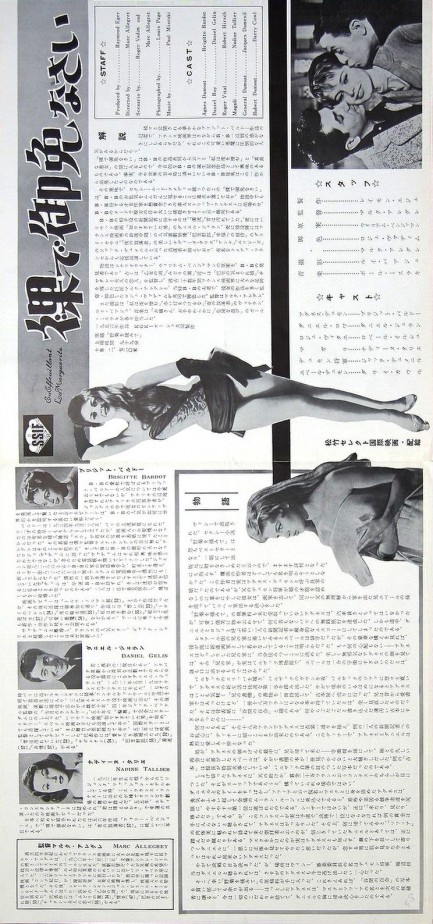 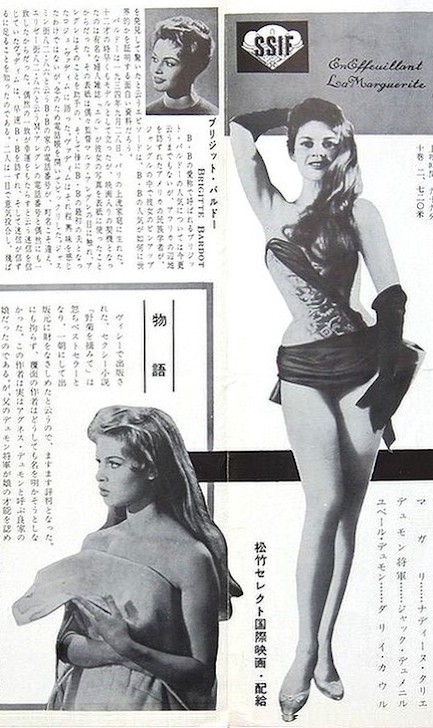   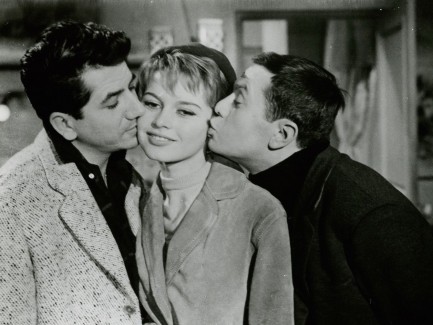 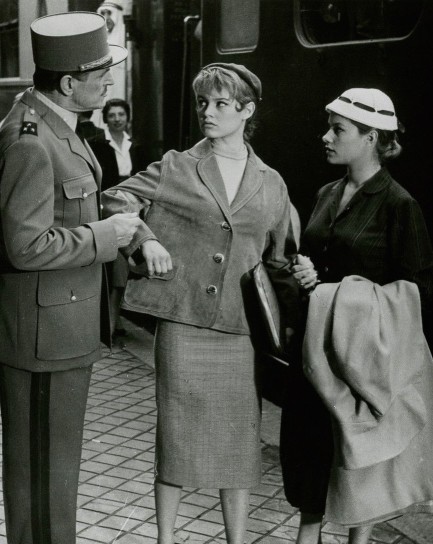 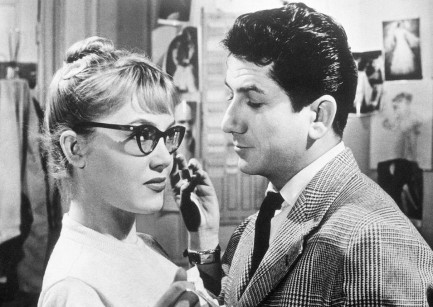 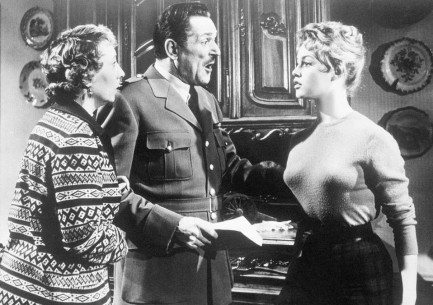 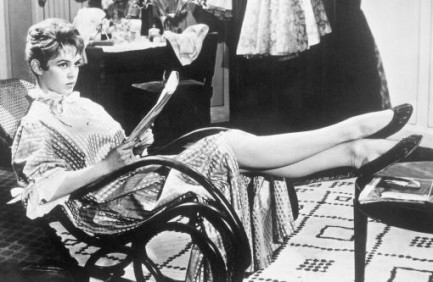 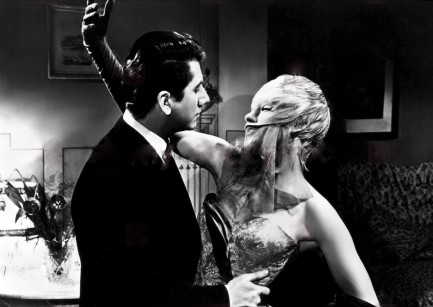 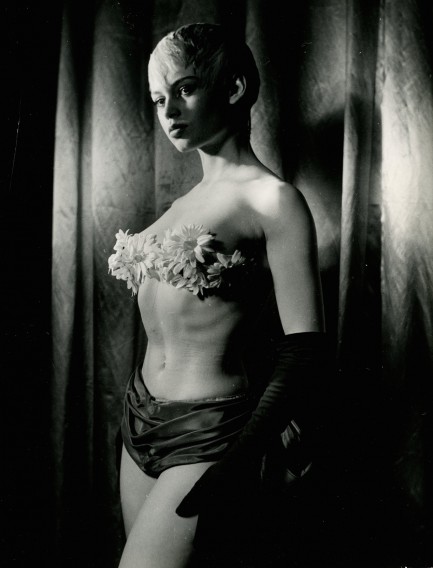 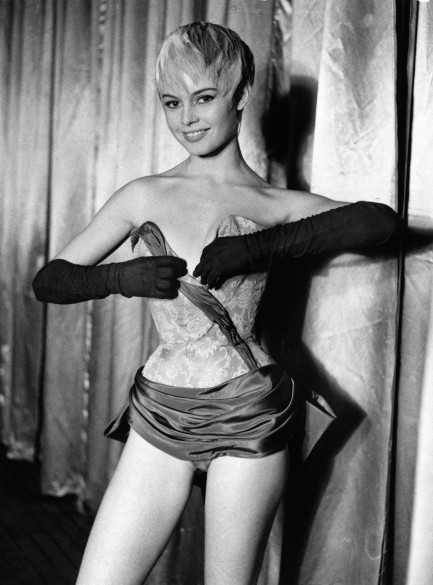 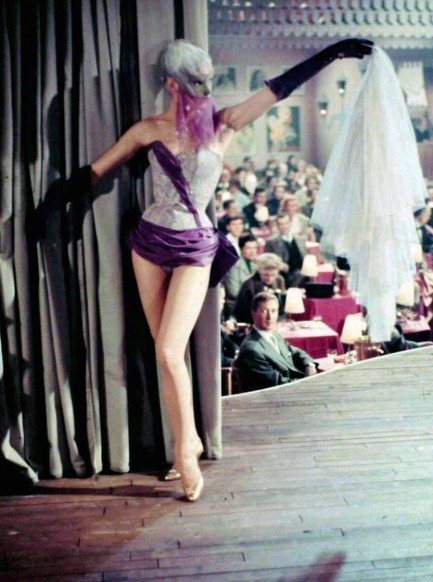 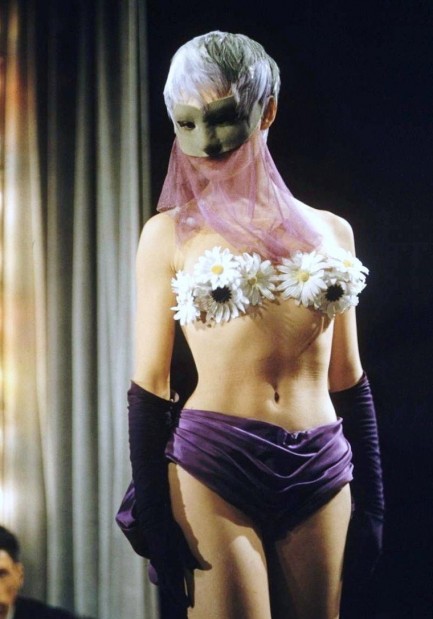 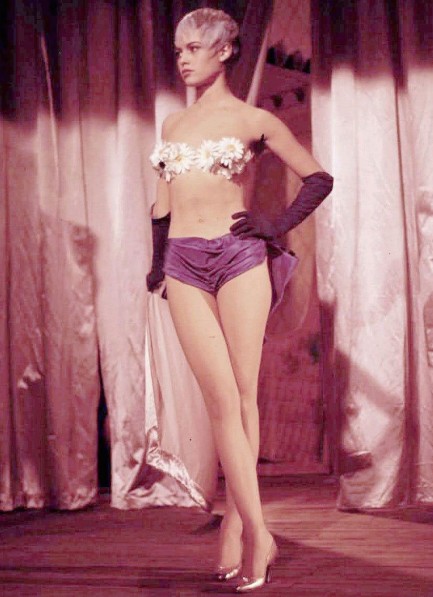 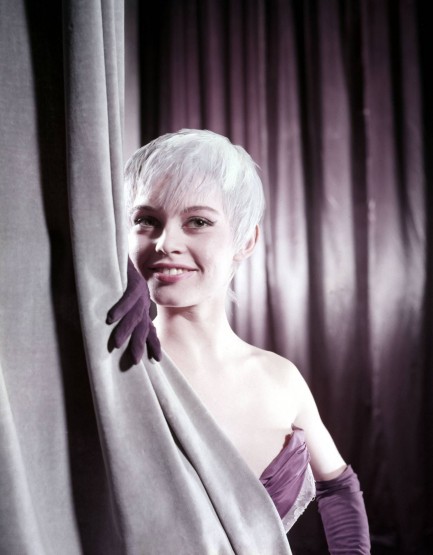
 The ocean is perfect for covering a multitude of sins. 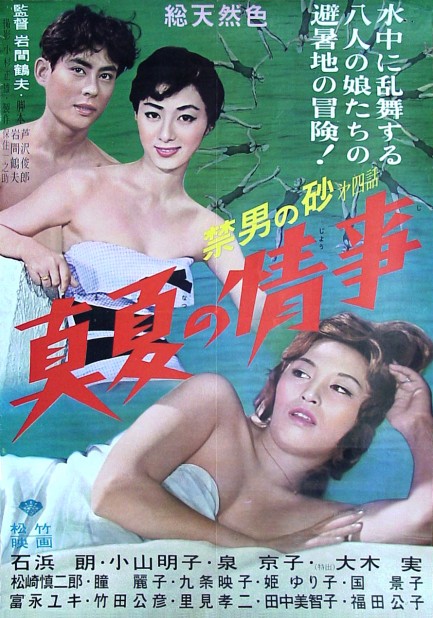 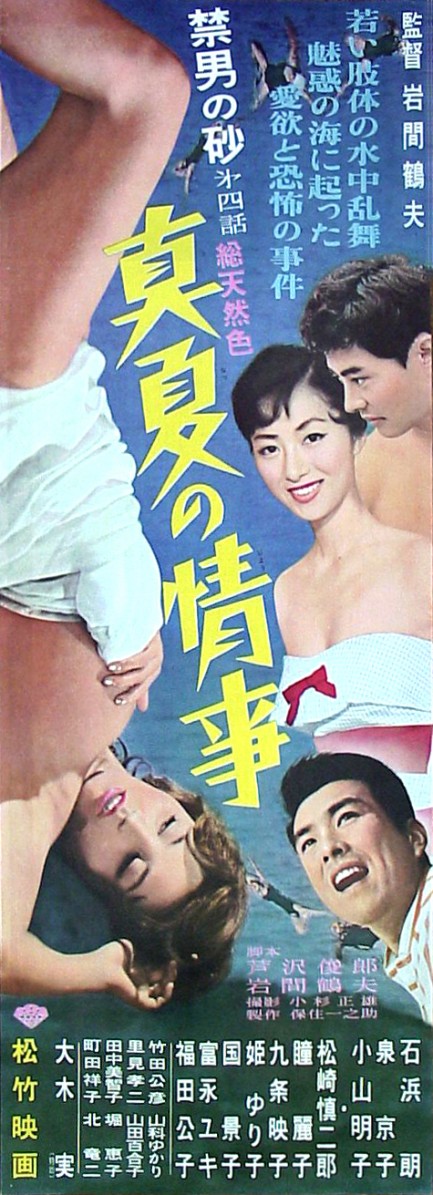
Manatsu no joji, aka Midsummer Affair—Underwater Series Part 4, appeared in 1960 from Shochiku Company Limited, and above you see two nice promo posters for the movie. These epics are, of course, nothing without franchise star Kyoko Izumi, and here she plays a woman discovered adrift on the sea. She tells her rescuers that her husband, less lucky, drowned trying to save her. But some elements of her story don't add up—for instance she claims to be a poor swimmer, but soon it becomes clear that she's quite at home in the water. Suspicions arise that Izumi has committed foul play, a fact soon clear enough to the audience. Meanwhile a swimwear fashion show and a bitter rivalry between two female aquatic teams give her the cover she needs to try to eliminate the person most intent on proving she murdered her husband. All she has to do is point and shoot—with a poison filled syringe. Will she get away with this crazy scheme? We're not telling. This was the last film in this franchise, but she did act in one more ama film, 1963's Ama no kaishinju, which was made by a different production company. So it looks like this'll do it for the series, except for an alternate poster for part 3 we have hiding somewhere. We'll get that up at some point.
 Kyoko Izumi drifts into dangerous waters. 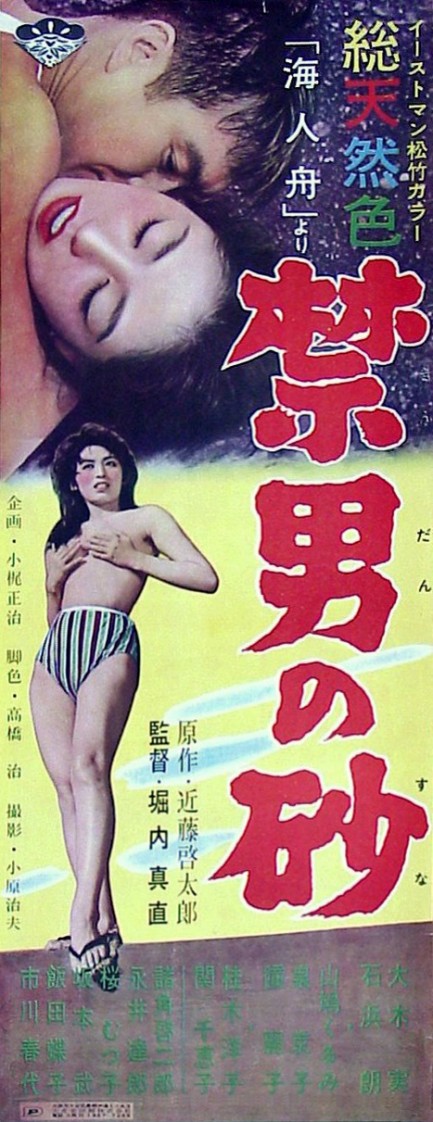
Yes, it's another movie from the Underwater Series. We already shared posters for installments two and three, which premiered in June 1958 and June 1959 respectively. The makers of these films really liked June premiere dates, because Ama bune yori: Kindan no suna premiered today in 1957. This is the film, based on a novel by Keitaro Konda, that launched the series. It tells the story of man who returns to his home fishing village after five years away and rekindles his relationship with a local ama, played by series star Kyoko Izumi. Problem is he isn't the one interested in Izumi, and the resulting love triangle eventually leads to tragedy, as is common in these movies. Incidentally, we can't be sure what the western title was for this, or whether there was one. Many of these obscure Japanese flicks never played outside Asia, and this may be one. In fact, there's so much conflicting information on this we can't be 100% we got everything right. We may have to make correction later, but the main thing is to enjoy the striking poster art. Actually, we're feeling pretty good about uploading all these ama posters, because some of them weren't available online. There are still more films from the genre for which we have art to share, so keep an eye out for that down the line. 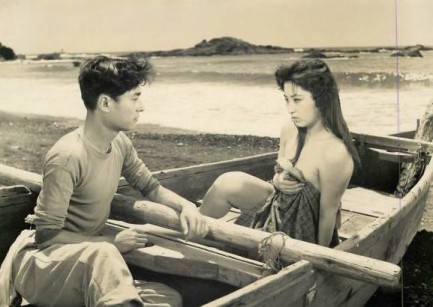 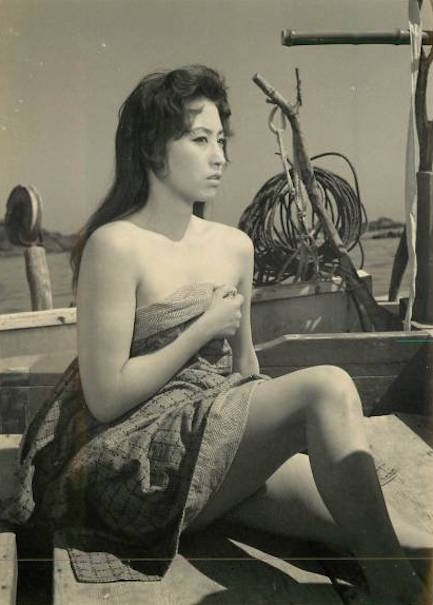 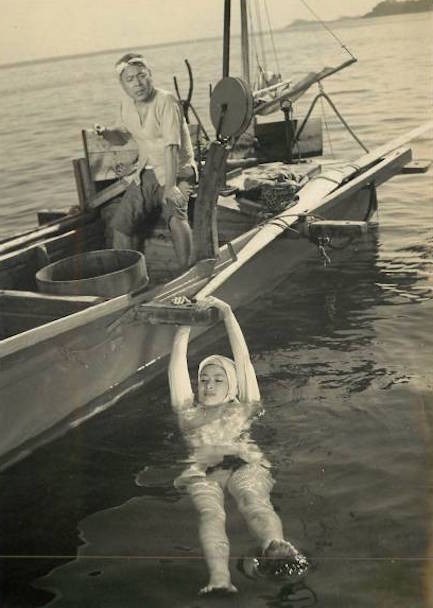 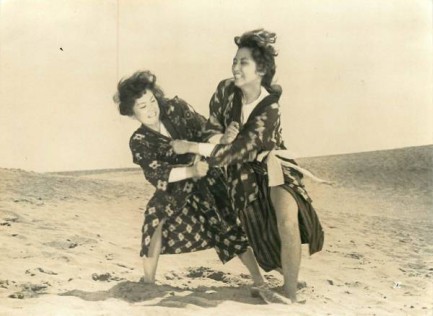 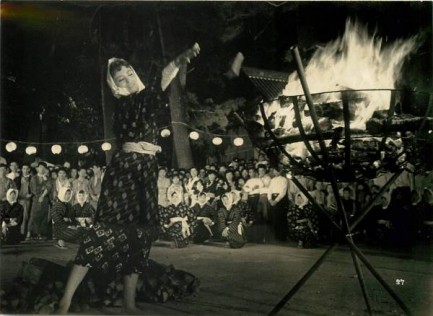
 Currents and caves are bad enough, but lies can drag you into really dangerous waters. 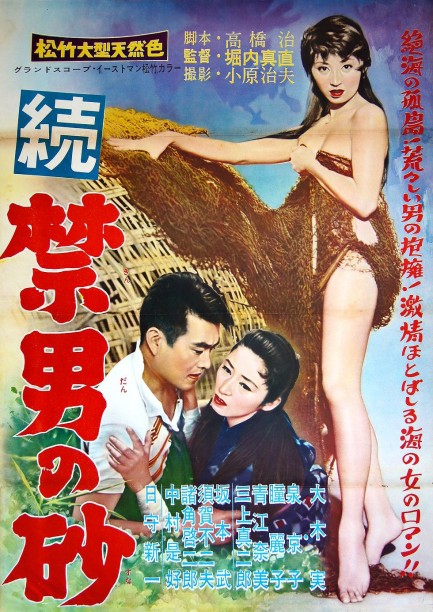 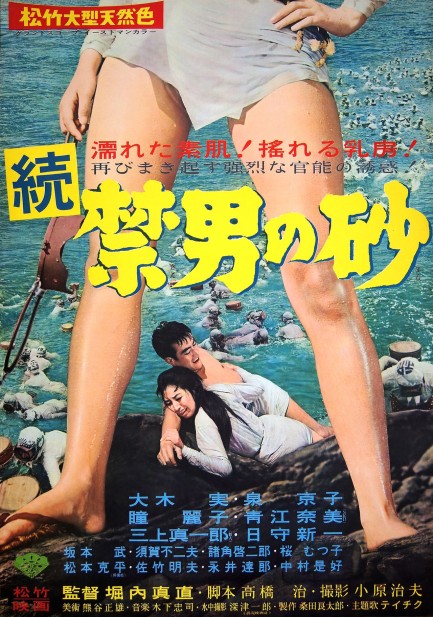
Last week we talked about the 1959 drama Zoku-zoku-Kindan no suna: Akai pantsu, third film in the Shochiku Co. franchise sometimes referred to as the Underwater Series. You know we're sticklers for talking about movies on their premiere dates, which is why today we're looking at Zoku kindan no suna, which opened in Japan today in 1958. In the west the movie was known as Forbidden Sands or The Prohibited Man's Sand, and like the others in the series deals with the loves and troubles of an ama—a female skin diver. Two bank robbers steal seven million yen, which we think is like forty or fifty bucks, and hide out on an island peopled by amas and their families. The crooks pretend to be a marine biology professor and his assistant, and they don scuba gear and hide the cash in some underwater caves known as the Dragon's Caves—a name which just screams trouble. They're convinced the treasure is inaccessible, but these amas are really good, and one in particular has no trouble at all making especially long dives. One of the crooks takes a shine to her, and warns her to stay out of the caves because they're dangerous, but the shine is mutual, so surprise surprise, as a gift she decides to swim down there to find rare specimens for his phony marine research. Yes, theft is one thing, but lies are a whole other bucket of starfish. Zoku kindan no suna is a recommendable flick, but be forewarned that if you're in the States it might be even harder to find than that loot in the Dragon's Caves. But at least you can enjoy the posters. We aren't done with this series, so keep an eye out for another installment in a bit.
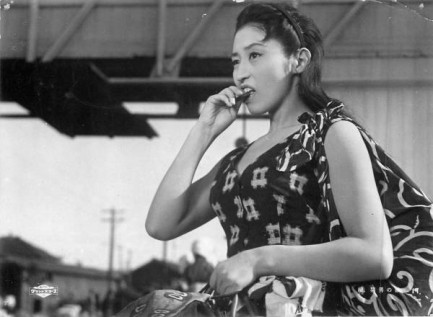 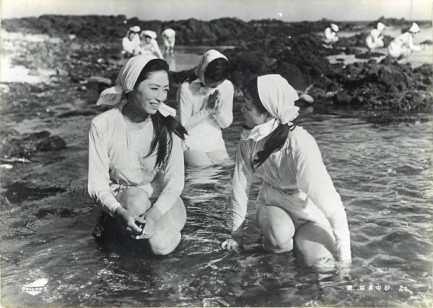 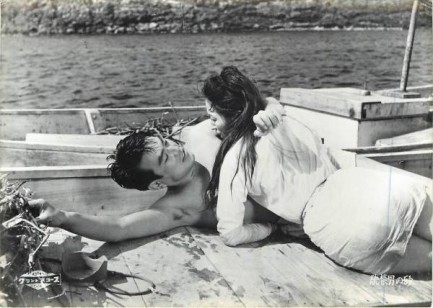 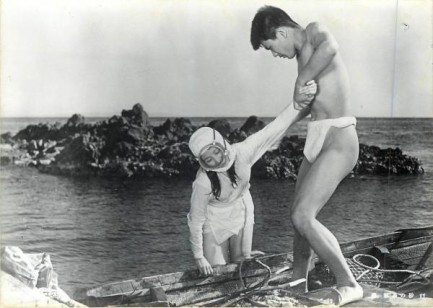 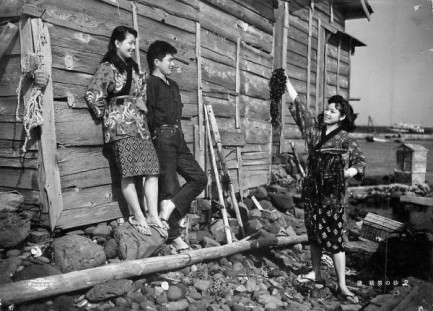
 If this is your idea of a romantic meeting place I don't think things will work out between us. 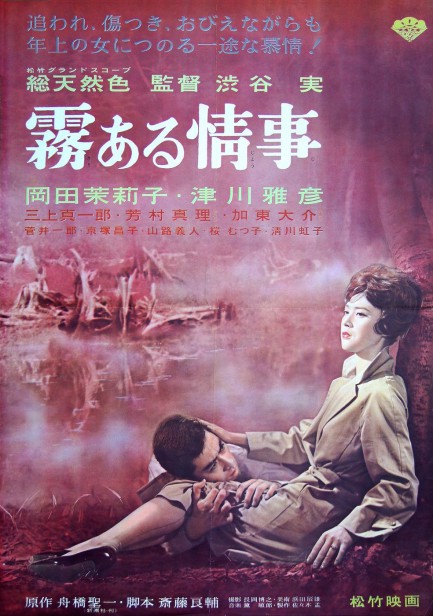
There isn't much online about the Japanese drama Kiri aru jyoji and we aren't going to be able to add much more. Well, except for this incredible promo poster, which we're sure has never appeared on any website before. So that's something at least. The movie premiered in 1959, came from Tokyo's venerable movie studio Shochiku Company Limited, and was directed by Minoru Shibuya. It starred Mariko Okada, a leading figure of the Japanese New Wave and one of the great stars of her era (and this era, actually, as she's still working steadily). Hopefully one day we'll track down this movie. For now—only the poster.
 Her Wicked, Wicked ways. 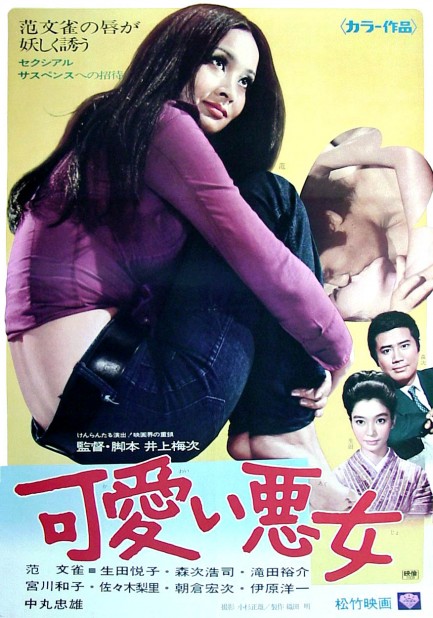
Above is a rare poster for a 1971 Japanese film entitled Kawaii akujo, known in English as The Lovely Wicked Woman, or sometimes The Lovely Bad Woman. You won’t find any info about the production online under the English titles because for some reason all the movie databases we consulted referred to it as Cute Vanity Fair. But trust us, this poster doesn’t say “cute vanity fair”, and we seriously doubt the movie was ever released in the West under that highly dubious title. It actually says "cute villain," and it wouldn't have been released in the West under that title either. Anyway, whatever you call the film, it was directed by Inoue Umetsugu and starred Bunjaku Han in a story of murder and intrigue centered around a tabloid newspaper. Han appeared in about twenty-five movies, including the classic pinku serial Stray Cat Rock, and starred on television scores of times before dying prematurely in 2002 at the age of fifty-four. We’ll have a bit more on her later.
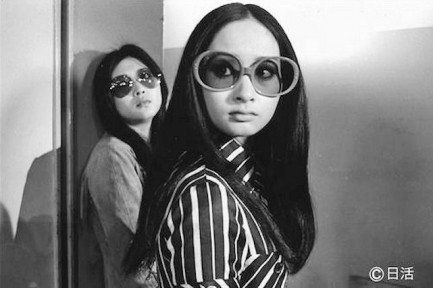
|
 |

The headlines that mattered yesteryear.
2003—Hope Dies
Film legend Bob Hope dies of pneumonia two months after celebrating his 100th birthday. 1945—Churchill Given the Sack
In spite of admiring Winston Churchill as a great wartime leader, Britons elect
Clement Attlee the nation's new prime minister in a sweeping victory for the Labour Party over the Conservatives. 1952—Evita Peron Dies
Eva Duarte de Peron, aka Evita, wife of the president of the Argentine Republic, dies from cancer at age 33. Evita had brought the working classes into a position of political power never witnessed before, but was hated by the nation's powerful military class. She is lain to rest in Milan, Italy in a secret grave under a nun's name, but is eventually returned to Argentina for reburial beside her husband in 1974. 1943—Mussolini Calls It Quits
Italian dictator Benito Mussolini steps down as head of the armed forces and the government. It soon becomes clear that Il Duce did not relinquish power voluntarily, but was forced to resign after former Fascist colleagues turned against him. He is later installed by Germany as leader of the Italian Social Republic in the north of the country, but is killed by partisans in 1945.
|

|
|

It's easy. We have an uploader that makes it a snap. Use it to submit your art, text, header, and subhead. Your post can be funny, serious, or anything in between, as long as it's vintage pulp. You'll get a byline and experience the fleeting pride of free authorship. We'll edit your post for typos, but the rest is up to you. Click here to give us your best shot.

|
|





